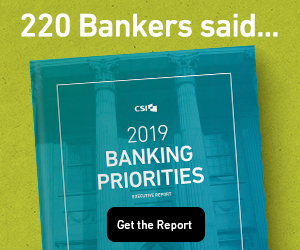|
This ABA Banking Journal newsletter is a free, twice-monthly supplement to the ABA Banking Journal magazine intended to help you stay on top of industry and policy news.
You can also stay abreast of banking news by visiting aba.com/BankingJournal, home to ABA Daily Newsbytes stories, digital exclusives, the ABA Banking Journal Podcast and more.
The NFIB Small Business Optimism Index fell slightly to 107.2, 0.6 point below May’s record reading. This was the sixth highest reading in the index’s 45 year history and just below the record level (108.0) reached in 1983. (ABA Banking Journal)
|
Libor has emerged over time as the dominant rate for determining interest payments on almost all adjustable-rate financial products. Now, regulators are stressing that the benchmark could be gone by 2021. (New York Times)
|
Early Warning Services LLC, the network operator behind Zelle, has released the results of its first Digital Payments Adoption Study ("study"). Results show that adoption and usage of digital person-to-person (P2P) payments are high among all generations, with consumers pointing to trust in friends and family and trust in their financial institutions as the primary reasons for engaging in a digital payment. (Finextra)
|
Today, bankers face a situation that they have not seen for more than 10 years: rising interest rates. It is important for bank management to re-examine and fully understand the sensitivity of deposit assumptions embedded in asset liability models and the potential impact to earnings and liquidity they present across a wide range of market scenarios. (ABA Banking Journal)
|
On the latest episode of the ABA Banking Journal Podcast, New Hampshire Mutual Bancorp President and CEO Gregg Tewksbury joins Philip Emma, president of Merrimack County Savings Bank, to discuss how the mutual holding company structure allows each bank to retain its unique community presence but benefit from shared services. (ABA Banking Journal)
|
There has been much talk in recent years about how blockchain technology can change the world, with far fewer tangible results. Now, after years of research and development, companies are using blockchain networks to conduct trade finance, track diamonds and prove the provenance of marijuana. (Bloomberg)
|
A new report from the technical consulting firm SNS Telecom & IT forecasts that the financial services industry will invest $9 billion in big data services this year. (Bank Innovation)
|
In remarks at the ABA Summer Leadership Meeting in Salt Lake City this week, Federal Reserve Vice Chairman for Supervision Randal Quarles signaled that the Fed would act sooner than required by S. 2155 to tailor prudential standards for banks between $100 billion and $250 billion in assets. (ABA Banking Journal)
|
Last month, President Trump nominated Kathy Kraninger to be the next director of the Bureau of Consumer Financial Protection (BCFP). While she isn’t a high-profile figure in politics or in the administration, that may be exactly what the BCFP needs right now. (The Hill)
|
In response to an executive order by President Trump, the U.S. Department of Justice launched a new task force on market integrity and consumer fraud. Led by Deputy Attorney General Rod Rosenstein, the group will focus on fraud against consumers as well as corporate fraud. (ABA Banking Journal)
|
Federal Reserve Chairman Jerome Powell recently expressed doubts about the usefulness of cryptocurrency for anything other than obscuring illegal activity, telling a House panel that virtual currencies such as bitcoin are too volatile to hold consistent value, pose serious risks to consumer safety and inhibit crackdowns on illicit finance. (The Hill)
|
|








